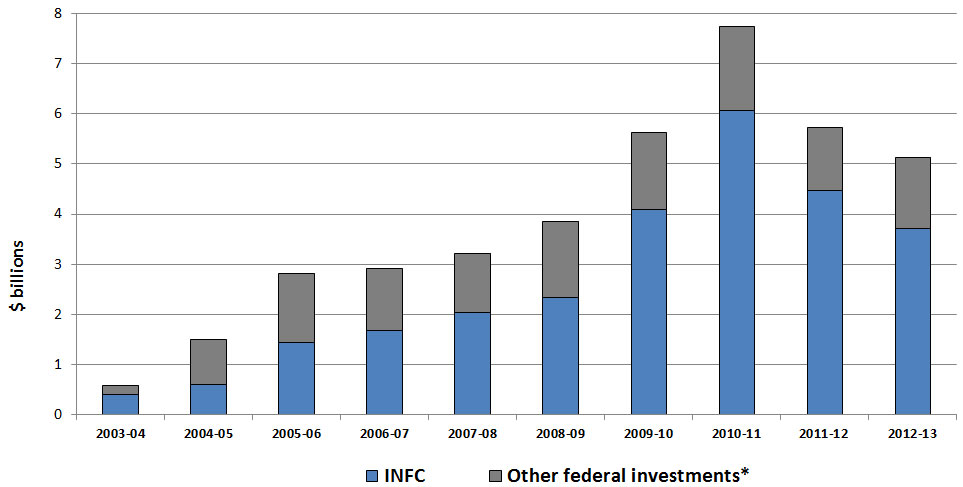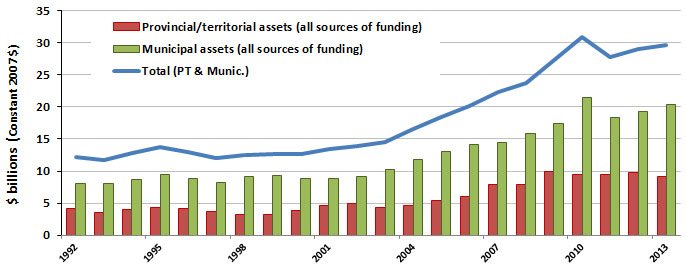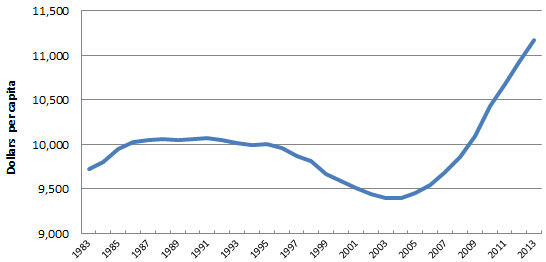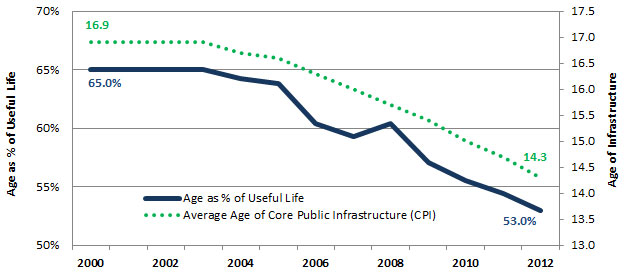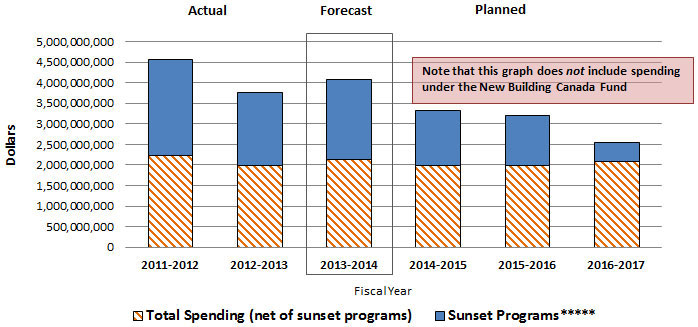2014-2015
Report on Plans and Priorities
Section 1
PDF Version (Size: 1.34 MB)
Help on accessing alternative formats, such as PDF, PPT and ZIP files, can be obtained in the alternate format help section.
Minister's Message

As Canada's Minister of Infrastructure, Communities and Intergovernmental Affairs and Minister of the Economic Development Agency of Canada for the Regions of Quebec, I am pleased to present Infrastructure Canada's Report on Plans and Priorities for 2014-2015. This report presents the Department's ongoing commitment to work with our partners, including all orders of government, stakeholders, and the private sector, to help them build, sustain and modernize a network of world-class public infrastructure for Canadians.
In Economic Action Plan 2013, the Government of Canada announced the largest long-term infrastructure plan in the country's history: the $53-billion New Building Canada Plan, which continues the tradition of infrastructure investment by supporting projects that focus on economic growth, job creation and productivity.
The Plan provides stable funding for a 10 year period, including:
- over $32 billion specifically available for municipalities through the renewed Gas Tax Fund and the incremental Goods and Services Tax Rebate for municipalities;
- a $14-billion New Building Canada Fund, which will have $10 billion for provinces and territories, with $1 billion of that reserved for local projects in small communities of less than 100,000 people, and $4 billion for nationally-significant projects; and
- $1.25 billion in new funding available through the P3 Canada Fund.
As we work on implementing the Plan, our existing programs will continue to provide funding to infrastructure projects across the country. This represents $6 billion dollars that will continue to flow to projects in 2014-15 and beyond, and this funding will ensure that upcoming construction seasons can be put to good use in delivering local infrastructure priorities.
These unprecedented investments attest to the government's unwavering commitment to strengthening public infrastructure. Infrastructure Canada has a proven track record of successfully delivering infrastructure funding programs, with more than 23,000 infrastructure projects supported since 2006. The Department will build on this solid experience as well as its prudent management practices and sound fiscal stewardship to effectively deliver the new programs, while completing delivery of our existing suite of programs.
I invite you to follow our progress at Infrastructure Canada as we move forward with our infrastructure investments, which continue to provide meaningful and lasting benefits for communities across Canada.
The Honourable Denis Lebel, P.C., M.P.
Minister Infrastructure, Communities and Intergovernmental Affairs and
Minister of the Economic Development Agency of Canada for the Regions of Quebec
Section I: Organizational Expenditure Overview
1.1 Organizational Profile
Minister: The Honourable Denis Lebel, P.C., M.P.
Deputy Head: Louis Lévesque
Ministerial Portfolio: Infrastructure, Communities and Intergovernmental Affairs and Economic Development Agency of Canada for the Regions of Quebec
Year Established: 2002
Main Legislative Authorities: Order in Council PC 2004-0325
Legislation related to the Gas Tax Fund:
- Keeping Canada's Economy and Jobs Growing Act, S.C. 2011, c. 24
- Economic Action Plan 2013 Act, No. 1, S.C. 2013, c. 33, section 233
Other: Infrastructure Canada works in collaboration with other federal departments and agencies to deliver its programs. These departments and agencies share their knowledge of local needs and priorities. Infrastructure Canada's Federal Delivery Partners are:
- Atlantic Canada Opportunities Agency;
- Economic Development Agency of Canada for the Regions of Quebec;
- Canadian Northern Economic Development Agency (CanNor);
- Federal Economic Development Agency for Southern Ontario (FedDev Ontario);
- Transport Canada; and
- Western Economic Diversification.
1.2 Organizational Context
1.2.1 Raison d'être
Strong, modern, world-class public infrastructure is a key factor in achieving the Government of Canada's priorities of a stronger economy, a cleaner environment, and more prosperous, safer communities. Infrastructure Canada leads the Government of Canada's efforts in addressing Canada's public infrastructure challenges.
1.2.2 Responsibilities
I. Overview
Infrastructure Canada is the main department responsible for federal efforts to enhance Canada's public infrastructure. This is accomplished through three main activities: investments in provincial, territorial and municipal assets; engagement in key partnerships with the provinces, territories, municipalities and the private sector; and the development and implementation of sound policies. Established in 2002, the Department ensures that Canadians benefit from world-class public infrastructure from coast to coast to coast.
Figure 1: Federal Support for Provincial, Territorial and Municipal Infrastructure
[*] Include infrastructure investments from Finance Canada, Transport Canada, Canada Revenue Agency, Aboriginal Affairs and Northern Development, Atlantic Canada Opportunities Agency, Canadian Northern Economic Development Agency, Economic Development Agency of Canada for the Regions of Quebec, Federal Economic Development Agency for Southern Ontario, Western Economic Diversification Canada, and the Royal Canadian Mounted Police. Source: Finance Canada and Infrastructure Canada, December 2013.
The Government of Canada's investments in public infrastructure over the past decade have leveraged funding from provinces, territories, municipalities and other partners, resulting in a significant overall increase in investment in the country's core public infrastructure (CPI)1 (Figure 2). Combined provincial/territorial and municipal infrastructure investments (in constant dollars) represented close to $30 billion in 2013.
Figure 2: Provincial/Territorial and Municipal Investments in Core Public Infrastructure** by Asset Owner
[**] Core Public Infrastructure (CPI) includes bridges, roads, water, wastewater, transit, plus cultural and recreational facilities. Data for 2013 based on forecast. Using constant (2007) dollars.
Note: Government investment in CPI include all grants and contributions from other levels of government.
Source: Statistics Canada, National Economic Analysis Division. Chart, data analysis and calculation: Infrastructure Canada.
The Importance of Infrastructure Investment
Canada's public infrastructure forms the backbone of our nation. From the water we drink to the roads we drive on, infrastructure benefits all Canadians each and every day. Our quality of life, prospering communities and resilient economy depend on our systems of public infrastructure. Public infrastructure investments support our economic growth and productivity by allowing goods and people to move more efficiently, facilitating trade activities, promoting local and regional development and supporting job creation.
Over the past decade, provincial, territorial and municipal governments, with funding support from the Government of Canada, have taken great strides in responding to infrastructure investment needs and building for a prosperous Canada. Indeed, sustained investment has improved the provision of public infrastructure available to Canadian families and businesses.
As shown in Figure 3, in Canada, the net stock2 value of core public infrastructure per capita has been rising significantly since the early 2000s, after having been on a declining trend from the early 1990s. It actually increased from less than $9,500 per capita in 2003 to about $11,200 in 2013.
Figure 3: Net Stock*** of Core Public Infrastructure per capita
[***] Net capital stock in constant (2007) dollars. Data for 2013 based on forecast. Source: Statistics Canada, National Economic Analysis Division. Chart, data analysis and calculation: Infrastructure Canada.
Recent, sustained investments have also contributed to the ongoing renewal and improvement of Canada's core public infrastructure. As seen in Figure 4, the average age of core public infrastructure is now declining after years of trending upwards. From its peak of 16.9 years in 2000 to 2003, the average age of core public infrastructure declined to 14.7 years in 2011 and 14.3 years forecasted for 2012.
Great advances have been made to lower the average age of infrastructure as a percentage of useful life. In Statistics Canada's terms, the "useful life" of an asset is its estimated productive life at the time of its acquisition. Between 2003 and 2012, the average age of Canada's core public infrastructure as a percentage of useful life fell from 65 percent to 53 percent. In terms of useful life, Canada's core public infrastructure is getting younger. At the same time, a value of 53 percent indicates that overall Canada's core public infrastructure is nearing or is past the halfway mark of its expected useful life.
Figure 4: Average Age and Age as a Percentage of Useful Life of Core Public Infrastructure (CPI)
Core Public Infrastructure (CPI) includes bridges, roads, water, wastewater, transit, plus cultural and recreational facilities. Data for 2012 based on forecast. Source: Statistics Canada, National Economic Analysis Division. Chart, data analysis and calculation: Infrastructure Canada.
While investments have been significant over recent years, across the country, all levels of government share the responsibility of ensuring that ongoing investments are made to maintain quality public infrastructure so Canada can remain competitive in the global marketplace.
The New Building Canada Plan: Building on Recent Successes
In 2007, the Government of Canada launched the $33-billion Building Canada plan, the first ever long-term, federal plan for infrastructure. Through the 2007 Building Canada plan, the Government of Canada supported thousands of projects that have given Canadians access to better public infrastructure, and have strengthened the national economy.
In Canada's Economic Action Plan announced in Budget 2009, the government acknowledged the important role infrastructure holds in stimulating and supporting the Canadian economy. As part of the plan, the $4 billion Infrastructure Stimulus Fund was established for construction-ready infrastructure projects, the Building Canada Fund-Communities Component was topped up with supplementary funding, the Green Infrastructure Fund was created, and the Provincial-Territorial Infrastructure Base Fund and the Building Canada Fund were accelerated to get projects started sooner than otherwise possible.
In Economic Action Plan 2013, the Government announced the New Building Canada Plan, a 10-year funding commitment starting in 2014-2015, to build roads, bridges, subways, commuter rail and other public infrastructure in cooperation with provinces, territories, municipalities and the private sector. The New Building Canada Plan provides over $53 billion in funding, including $47.45 billion in new funding under three key funds: the Community Improvement Fund, the New Building Canada Fund, and the renewed P3 Canada Fund.
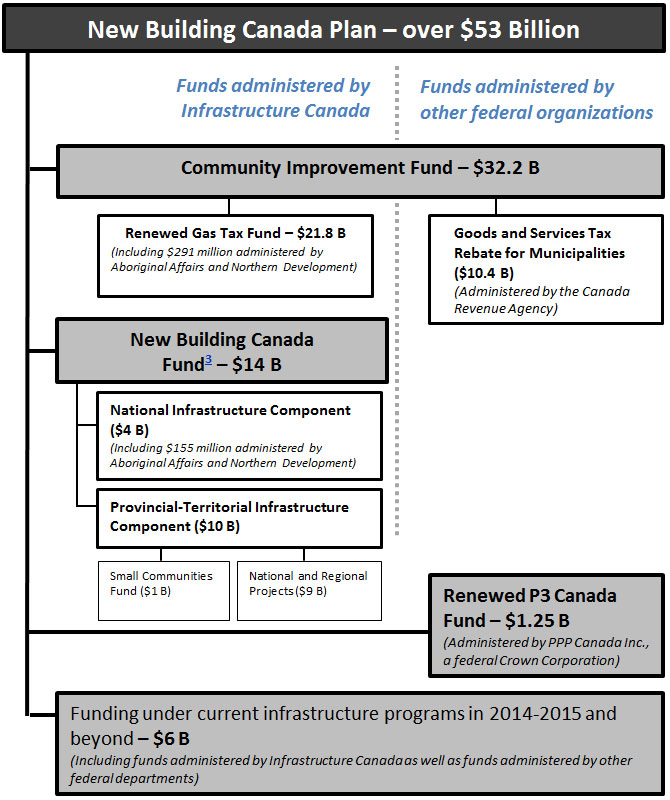
II. Transfer Payment Programs
In 2014-2015, Infrastructure Canada will continue to oversee billions of dollars' worth of infrastructure investments. This includes projects being delivered through transfer payment programs under the New Building Canada Plan, programs under the 2007 Building Canada plan, now in a later stage of their lifecycle, as well as other sunsetting programs.
Infrastructure Canada's suite of transfer payment programs addresses local and regional infrastructure needs while advancing national priorities. These programs help to make Canada's economy stronger, keep people and goods on the move, and contribute to cleaner air and water.
Infrastructure Canada's current transfer payment programs at a glance:4
Funding for Provincial-Territorial Priorities
The Provincial-Territorial Infrastructure Base Fund
($2.275 billion, announced in Budget 2007)
Through the Provincial-Territorial Infrastructure Base Fund, each jurisdiction receives base funding to address its core infrastructure priorities. All provinces and territories benefit from this investment in modern public infrastructure, particularly jurisdictions with smaller populations.
Permanent and Flexible Public Infrastructure Funding
The Gas Tax Fund
($21.5 billion, announced in Budget 2013/Economic Action Plan 2013)
Building on the previous Gas Tax Fund (GTF), which allocated $13 billion between 2005 and 2014, the renewed GTF is part of the $53 billion New Building Canada Plan. Beginning in 2014, and over the next 10 years, it will provide Canada's municipalities with over $2 billion annually in permanent, predictable and flexible funding to address local infrastructure priorities. The renewed GTF is now indexed at 2 percent per year and will give municipalities greater flexibility to spend federal funding on a broader range of infrastructure priorities.
Investments in National Infrastructure Priorities
The New Building Canada Fund—National Infrastructure Component5
($4 billion, announced in Budget 2013/Economic Action Plan 2013)
The New Building Canada Fund—National Infrastructure Component is part of the $53 billion New Building Canada Plan. Beginning in 2014-2015, this 10-year, merit-based program will support investments in public infrastructure projects of national significance, particularly those that support job creation, economic growth and productivity.
The Inuvik to Tuktoyaktuk Highway Fund
($200 million announced in Budget 2011 and augmented in 2013)
The Inuvik to Tuktoyaktuk Highway Fund supports the construction of an all season road between Inuvik and Tuktoyaktuk in the Northwest Territories, completing Canada's road network from coast to coast to coast. This road will strengthen Canada's Arctic presence and contribute to economic and social development in the North.
The Green Infrastructure Fund
($1 billion, announced in Budget 2009/Economic Action Plan)
The Green Infrastructure Fund targets projects that will improve the quality of the environment and lead to a more sustainable economy over the long term. More specifically, this merit-based funding program supports projects that promote cleaner air, cleaner water and reduced greenhouse gas emissions.
The Border Infrastructure Fund
($600 million, announced in Budget 2001)
The Border Infrastructure Fund invests in physical and transportation system infrastructure and improved analytical capacity at border crossings. As the Fund helps sustain and increase the long-term efficiency of the Canada-U.S. border, it is critical to Canada's growing economic and trade relationship with the United States.
Large-Scale Infrastructure Investments
The New Building Canada Fund—Provincial-Territorial Infrastructure Component6
(Announced in Budget 2013/Economic Action Plan 2013)
National and Regional Projects (NRP) sub-component — $9 billion
The New Building Canada Fund—Provincial-Territorial Infrastructure Component is part of the $53 billion New Building Canada Plan. Beginning in 2014-2015, this 10-year program will support public infrastructure projects of national, regional and local significance across the country in a broad range of categories. This component of the New Building Canada Fund will include base funding for each province and territory. Through its National and Regional Projects (NRP) sub-component, this program will deliver $9 billion towards projects of national and regional significance.
The Building Canada Fund—Major Infrastructure Component
($6.7 billion announced in Budget 2007)
The Building Canada Fund—Major Infrastructure Component targets large infrastructure projects of national or regional significance. It increases overall investment in public infrastructure and contributes to broad federal objectives of economic growth, a cleaner environment and strong and prosperous communities. The objective is to target two-thirds of the funding to national priorities of water, wastewater, public transit, the core national highway system and green energy.
The Canada Strategic Infrastructure Fund
($4.3 billion, announced in the 2001 and 2003 Budgets)
The Canada Strategic Infrastructure Fund supports projects that sustain economic growth and improve the quality of life of Canadians. Investment categories include: highways and railways, local transportation, tourism and urban development, water and sewage, and broadband (telecommunications connectivity).
Infrastructure Investments in Smaller Communities
The New Building Canada Fund—Provincial-Territorial Infrastructure Component6
(Announced in Budget 2013/Economic Action Plan 2013)
Small Communities Fund (SCF) sub-component — $1 billion
The New Building Canada Fund—Provincial-Territorial Infrastructure Component is part of the $53 billion New Building Canada Plan. Beginning in 2014-2015, this 10-year program will support public infrastructure projects of national, regional and local significance across the country in a broad range of categories. This component of the New Building Canada Fund will include base funding for each province and territory. Through its Small Communities Fund (SCF) sub-component, this program will deliver $1 billion specifically towards local projects in small communities of less than 100,000 people.
The Building Canada Fund—Communities Component
($1.5 billion, announced in Budget 2007 and augmented in Budget 2009/Economic Action Plan)
The Building Canada Fund—Communities Component targets projects in communities with populations of less than 100,000. The Fund recognizes the unique infrastructure needs of Canada's smaller communities and focuses on projects that meet environmental, economic and quality of life objectives. (Originally a $1 billion fund, Canada's Economic Action Plan expanded the Communities Component fund with a top-up of $500 million.)
1.3 Strategic Outcomes and Program Alignment Architecture (PAA)
For the planning period of 2014-2015, Infrastructure Canada's Program Alignment Architecture (PAA) was amended to include one Strategic Outcome and five Programs, as well as Internal Services in support of its activities. These Programs are discussed in detail in Section II of this report.
1. Strategic Outcome: Public Infrastructure for a More Prosperous Canada
1.1 Program: Funding for Provincial-Territorial Priorities
1.2 Program: Permanent and Flexible Public Infrastructure Funding
1.3 Program: Investments in National Infrastructure Priorities
1.4 Program: Large-Scale Infrastructure Investments
1.5 Program: Infrastructure Investments in Smaller Communities
Together, these five Programs outline the Department's key business lines and initiatives for the year. They also provide the framework under which our transfer payment programs are grouped as was described in the previous section.
All five Programs result in the construction and enhancement of public infrastructure, contributing to the Department's Strategic Outcome for a more prosperous Canada. The design features of these programs are reflected in the Department's performance measurement approach.
Program Alignment Architecture Crosswalk:
In 2013-2014, Infrastructure Canada's Program Alignment Architecture (PAA) included two Strategic Outcomes and nine Programs, as outlined below:
Strategic Outcome 1:
- Provinces, territories and municipalities have federal financial support for their infrastructure priorities
- Programs:
- Provincial-Territorial Infrastructure Base Fund
- Gas Tax Fund
Strategic Outcome 2:
- Funding for quality, cost-effective public infrastructure that meets the needs of Canadians in a competitive economy, a cleaner environment and liveable communities is provided
- Programs:
- Building Canada Fund—Communities Component
- Building Canada Fund—Major Infrastructure Component
- Green Infrastructure Fund
- Canada Strategic Infrastructure Fund
- Municipal Rural Infrastructure Fund
- Border Infrastructure Fund
- Economic Analysis and Research
Internal Services
For the planning period of 2014-2015, Infrastructure Canada moved towards a streamlined and more robust PAA that better reflects the Department's core activity, which supports a more prosperous Canada. Furthermore, the PAA was amended to account for funding under the new Building Canada Fund and to provide longer-term stability as changes in transfer payment programs and departmental priorities can be more easily accommodated within this new structure.
Under the new PAA the Department's transfer payment programs, which used to correspond to the PAA's "Programs", have now become grouped under one of the five new, higher-order Programs. Each of the five Programs is described in greater detail in Section II of this report.
1.4 Organizational Priorities
Four organizational priorities will guide the Department's work in 2014-2015. These are:
| Priority | Type7 | Program(s) |
|---|---|---|
| Work with partners to implement renewed Gas Tax Fund agreements | New | Program: Permanent and Flexible Public Infrastructure Funding |
| Description | ||
Why is this a priority?
What are the plans for meeting this priority: With the permanent GTF's terms and conditions approved, the priority will be to ensure that all federal-PT agreements are signed and flow the first instalment of permanent GTF in July 2014. |
||
| Priority | Type | Program(s) |
|---|---|---|
| Work with funding partners to implement the New Building Canada Fund | New | Programs:
|
| Description | ||
Why is this a priority?
What are the plans for meeting this priority: Infrastructure Canada will continue to consult with the Federation of Canadian Municipalities and other stakeholders to finalize the parameters of the New Building Canada Fund and is committed to launching the new Fund by March 31, 2014. |
||
| Priority | Type | Program(s) |
|---|---|---|
| Work with funding partners in the continued implementation of existing programs, while providing prudent stewardship and oversight of these programs | Ongoing | Programs:
|
| Description | ||
Why is this a priority?
What are the plans for meeting this priority: The Department will continue to work with provincial, territorial and municipal governments to identify new infrastructure projects, commit remaining funding and advance projects through the approval and funding agreement negotiation process, while ensuring continued prudent stewardship and oversight. The Department will ensure proper file closure for projects under the 2007 Building Canada Plan and sunsetting programs, including project and program audits and evaluations, as required. The Department will also continue to work with its partners to ensure timely completion of projects. |
||
| Priority | Type | Program(s) |
|---|---|---|
| Continue to implement operational efficiencies in the effective delivery of the Department's mandate | Previously committed to | Programs:
|
| Description | ||
Why is this a priority?
What are the plans for meeting this priority: Building on the ongoing implementation of lessons learned from over a decade of infrastructure programming, Infrastructure Canada will continue to focus on prudent stewardship while implementing its programs, pursuing further cost efficiencies in a restrained fiscal environment. In particular, efficiencies in the delivery of the New Building Canada Fund will be derived from a program design that is more risk-based overall, using a streamlined approval process and more efficient internal processes. Infrastructure Canada will continue to work with central agencies to confirm operating funding for 2014-2015 and future years to stabilize the operations of the Department. Infrastructure Canada will also continue to strengthen its expenditure management system by enhancing the challenge function and conducting due diligence reviews of information included in Cabinet documents, and attesting to the quality of the information. The Department will also continue to work with the Office of the Comptroller General of Canada (OCG) to refine the departmental corporate costing model in support of baseline costing of departmental operations and contribution programs, in keeping with current trends of costing methodologies. |
||
1.5 Risk Analysis
Key Risks
| Risk | Risk Response Strategy | Link to Program Alignment Architecture |
|---|---|---|
| Timely launch of the New Building Canada Plan programs | The Department is working with provinces, territories, municipal associations and municipalities to ensure that agreements for the renewed GTF are signed to allow the 2014-2015 payments to flow. For the New Building Canada Fund programs, once parameters are in place, the Department will work in collaboration with provinces, territories and municipalities to ensure that processes and agreements are in place to allow for identification and approval of new projects. |
|
| Management of the transfer of the Shared Information Management System for Infrastructure (SIMSI) hosting to Shared Services Canada while effectively addressing INFC's SIMSI-related needs | The Department will continue to foster a strong relationship with Shared Services Canada (SSC), including holding weekly meetings with the SSC Transition Team Working Group, biweekly meeting with the SSC Transition Directors' Team and quarterly meetings with a DG-level SSC Transition team. |
|
| Ensuring resource management challenges do not diminish the Department's ability to fully deliver its mandate | The Department is focusing on implementing key strategic actions from its Integrated Business and Human Resources Plan to address staffing challenges and is also adapting its organizational structure to ensure proper alignment of its resources to effectively deliver on its priorities. |
|
The Department applies a comprehensive approach to identify, assess and manage risks at the strategic, operational, program and project levels. This approach includes conducting regular environmental scans with direct participation of the Department's executives. The most recent update to the Corporate Risk Profile reflects announcements in the Economic Action Plan 2013 including the programs under the New Building Canada Plan. In 2014-2015, the Department will monitor and report on its risk responses, as well as review and update risks in the context of emerging environmental risk factors and progress made by the implementation of risk responses.
1.6 Planned Expenditures
| 2014-2015 Main Estimates8 | 2014-2015 Planned Spending8 | 2015-2016 Planned Spending8 | 2016-2017 Planned Spending8 |
|---|---|---|---|
| 3,321,597,771 | 3,321,597,771 | 3,179,615,619 | 2,544,531,472 |
| 2014-2015 | 2015-2016 | 2016-2017 |
|---|---|---|
| TBD9 | TBD9 | TBD9 |
| Strategic Outcome, Programs and Internal Services | 2011-2012 Expenditures | 2012-2013 Expenditures | 2013-2014 Forecast Spending | 2014-2015 Main Estimates10 | 2014-2015 Planned Spending10 | 2015-2016 Planned Spending10 | 2016-2017 Planned Spending10 |
|---|---|---|---|---|---|---|---|
| Strategic Outcome: Public Infrastructure for a More Prosperous Canada | |||||||
| Funding for Provincial-Territorial Priorities | 188,695,432 | 236,858,957 | 321,031,182 | 55,351,611 | 55,351,611 | 0 | 0 |
| Permanent and Flexible Public Infrastructure Funding | 2,206,246,353 | 1,965,101,267 | 2,108,876,567 | 1,973,411,002 | 1,973,411,002 | 1,973,411,002 | 2,072,074,474 |
| Investments in National Infrastructure Priorities | 65,315,284 | 123,950,005 | 189,684,160 | 193,145,913 | 193,145,913 | 133,788,508 | 133,212,825 |
| Large-Scale Infrastructure Investments | 948,209,666 | 1,162,603,384 | 1,198,298,550 | 958,832,530 | 958,832,530 | 836,150,579 | 337,403,794 |
| Infrastructure Investments in Smaller Communities | 301,926,560 | 221,479,608 | 228,370,854 | 139,431,232 | 139,431,232 | 234,823,236 | 398,085 |
| Programs under former PAA**** | 774,192,222 | 557,453 | |||||
| Strategic Outcome Subtotal | 4,484,585,517 | 3,710,550,674 | 4,046,261,313 | 3,320,172,288 | 3,320,172,288 | 3,178,173,325 | 2,543,089,178 |
| Internal Services Subtotal11 | 55,524,756 | 42,105,718 | 29,906,605 | 1,425,48311 | 1,425,48311 | 1,442,29411 | 1,442,29411 |
| Total | 4,540,110,273 | 3,752,656,392 | 4,076,167,918 | 3,321,597,771 | 3,321,597,77112 | 3,179,615,61912 | 2,544,531,47212 |
[****] Note: sunsetted programs under the previous Program Alignment Architecture: Infrastructure Stimulus Fund, Building Canada Fund-Communities Component Top-Up, and Economic Analysis and Research.
Building on the Government of Canada's existing infrastructure investments, Economic Action Plan 2013 introduced the New Building Canada Plan valued at $53 billion. Included in this Plan is the renewed Gas Tax Fund, which will continue to support the infrastructure priorities of Canadian communities. Starting in 2014-2015, Infrastructure Canada will work with provinces, territories and municipalities to implement the new Gas Tax Fund agreements. Over the 10-year life of the Plan, the Gas Tax Fund will provide close to $22 billion in permanent, predictable and flexible public infrastructure funding for municipalities.
Another key component of the New Building Canada Plan is the $14 billion New Building Canada Fund, including the National Infrastructure Component and the Provincial-Territorial Infrastructure Component. Infrastructure Canada continues to consult with the Federation of Canadian Municipalities and other stakeholders to finalize the parameters of the New Building Canada Fund and is committed to launching the new Fund by March 31, 2014.
While working on these new transfer payment programs, Infrastructure Canada will continue to work with its partners to ensure the timely completion of projects under current programs such as the Building Canada Fund—Major Infrastructure Component, the Building Canada Fund—Communities Component, the Green Infrastructure Fund, and other sunsetting funds.
In 2014-2015, the delivery of the renewed Gas Tax Fund as well as existing funds, not counting the New Building Canada Fund, represent a total spending of $3.3 billion towards the construction of public infrastructure across the country. As funding for the new programs is confirmed and projects commence in 2014-2015 and beyond, the Department's planned spending figures will be adjusted accordingly. As in the past, Infrastructure Canada will pursue operational efficiencies in 2014-2015 and will effectively deliver its mandate through the prudent management, stewardship and implementation of infrastructure funding programs to ensure ongoing value for taxpayers.
Building on a history of successful and collaborative projects, Infrastructure Canada is committed to working with partners and stakeholders to improve public infrastructure across Canada, while continuing to lead the Government of Canada's efforts to address the public infrastructure needs of the country.
1.6.1 Alignment to Government of Canada Outcomes
| Strategic Outcome | Program | Spending Area | Government of Canada Outcome | 2014-2015 Planned Spending |
|---|---|---|---|---|
| Public Infrastructure for a More Prosperous Canada | Funding for Provincial-Territorial Priorities | Economic Affairs | Strong Economic Growth | 55,351,611 |
| Permanent and Flexible Public Infrastructure Funding | Economic Affairs | Strong Economic Growth | 1,973,411,002 | |
| Investments in National Infrastructure Priorities | Economic Affairs | Strong Economic Growth | 193,145,913 | |
| Large-Scale Infrastructure Investments | Economic Affairs | Strong Economic Growth | 958,832,530 | |
| Infrastructure Investments in Smaller Communities | Economic Affairs | Strong Economic Growth | 139,431,232 |
| Spending Area | Total Planned Spending14 |
|---|---|
| Economic Affairs | 3,320,172,288 |
1.7 Departmental Spending Trend
1.7.1 Spending Trends
In 2014-2015, Infrastructure Canada plans to spend $3.3 billion on infrastructure investments under its Programs to meet the expected program results and contribute to its Strategic Outcome.
Figure 5: Departmental Spending Trend
[*****] Note: "Sunset Programs" are time-limited programs that do not have an ongoing funding and policy authority.
1.7.2 Variations in Program Spending Trends
Overall, Figure 5 highlights the stability and predictability of infrastructure funding provided through the Gas Tax Fund (GTF) (as shown by the hatchings in the graph) with spending at around $2 billion a year. The GTF is the only transfer payment program in this graph not being considered as a "Sunset Program" as per Treasury Board's definition.
In 2014-2015 and beyond, the Department will continue to flow funding towards the implementation of its existing transfer payment programs, as well as towards programs under the New Building Canada Plan, as part of Economic Action Plan 2013. Given that Figure 5 does not include planned spending for the programs under the New Building Canada Fund, the graph shows a general decrease in spending levels under "Sunset Programs" since existing programs are winding down. Planned spending for the new programs was not included as it was not in Infrastructure Canada's budgetary financial resources at the time this report was produced.
The peak in spending in 2011-2012 reflects the successful close-out of two Infrastructure Canada programs under the 2009 Economic Action Plan (EAP): the Infrastructure Stimulus Fund and the Building Canada Fund-Communities Component Top-Up. At the same time, the Department continued to implement programs under the 2007 Building Canada plan.
1.8 Estimates by Vote
For information on Infrastructure Canada's organizational appropriations, please see the 2014-2015 Main Estimates publication. An electronic version of the Main Estimates is available at: 2014-2015 Main Estimates.
1.9 Contribution to the Federal Sustainable Development Strategy (FSDS)
The 2013-16 Federal Sustainable Development Strategy (FSDS)15, tabled on November 4, 2013, guides the Government of Canada's 2013-16 sustainable development activities. The FSDS articulates Canada's federal sustainable development priorities for a period of three years, as required by the Federal Sustainable Development Act (FSDA).
Infrastructure Canada continues to play an important role in helping to create a more sustainable future for Canadians. The Department's broad range of infrastructure programs supports thousands of projects across Canada that contribute to a cleaner environment in areas such as drinking water, wastewater, clean energy, public transit and brownfield redevelopment. Many of these infrastructure investments support two of the FSDS Themes:
- Maintaining Water Quality and Availability.
- Addressing Climate Change and Air Quality.
Beyond providing funding through federal infrastructure funding programs, Infrastructure Canada's measures support the Federal Sustainable Development Strategy's Theme 4, Shrinking the Environmental Footprint — Beginning with Government. The Department continues to implement measures in green procurement, waste and energy reduction and awareness and promotion. Details on the Department's green procurement initiatives can be found in the Greening Government Operations (GGO) table of the Supplementary Information Tables of this Report on Plans and Priorities at: Infrastructure Canada Publications.
Footnotes
[1] Statistics Canada defines "core public infrastructure" (CPI) as consisting of the following asset categories: bridges, roads, water, wastewater, public transit, and cultural and recreational facilities. CPI excludes educational and health facilities.
[2] Capital Stock provides a measure of accumulated capital investment. "Net Capital Stock" is defined as the value of all fixed assets still in use, adjusted for the depreciation (age) of these assets.
[3] Includes resources for program administration.
[4] Original allocations for Transfer Payment Programs; these do not reflect transfers out and reallocations to other Government priorities.
[5] At the time of production of this report, the New Building Canada Fund-National Infrastructure Component was not included in Infrastructure Canada's budgetary financial resources.
[6] At the time of production of this report, the New Building Canada Fund-Provincial-Territorial Infrastructure Component was not included in Infrastructure Canada's budgetary financial resources.
[7] Type is defined as follows: previously committed to—committed to in the first or second fiscal year prior to the subject year of the report; ongoing—committed to at least three fiscal years prior to the subject year of the report; and new—newly committed to in the reporting year of the Report on Plans and Priorities.
[8] Funding for the transfer payment programs under the New Building Canada Fund is not reflected in the 2014-2015 Main Estimates and 2014-2015 Planned Spending, nor in the 2015-2016 and 2016-2017 Planned Spending. As well, the 2014-2015 Main Estimates and 2014-2015 Planned Spending and future years' amounts do not reflect funding for Infrastructure Canada's operating budget, except for small opening balances.
[9] The number of full-time equivalents (FTE) for 2014-2015 is to be determined (TBD). The number of FTEs for future years is to be determined depending on the status of ongoing operational funding, and on the elements of future public infrastructure programming.
[10] Funding for the transfer payment programs under the New Building Canada Fund is not reflected in the 2014-2015 Main Estimates and 2014-2015 Planned Spending, nor in the 2015-2016 and 2016-2017 Planned Spending.
[11] Internal Services funding amounts for 2014-2015 and beyond represent opening balances only.
[12]Funding for the transfer payment programs under the New Building Canada Fund is not reflected in the 2014-2015 Main Estimates and 2014-2015 Planned Spending, nor in the 2015-2016 and 2016-2017 Planned Spending. As well, the 2014-2015 Main Estimates and 2014-2015 Planned Spending and future years' amounts do not reflect funding for Infrastructure Canada's operating budget, except for small opening balances.
[13] Treasury Board Secretariat's Whole-of-Government Framework is available at: Whole-of-Government Framework.
[14] The Total Planned Spending does not reflect funding for the transfer payment programs under the New Building Canada Fund.
- Date modified:
